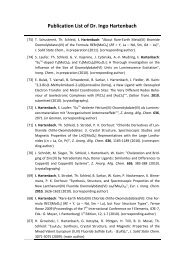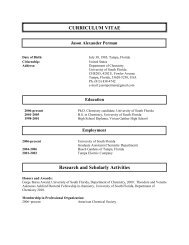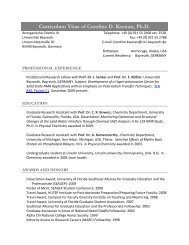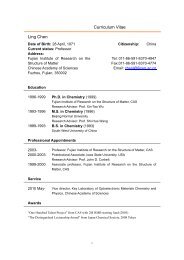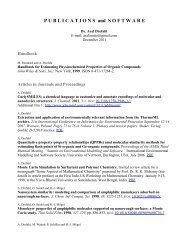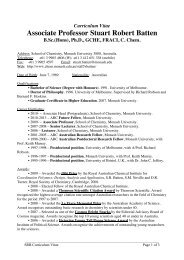Sports Drinks: Don't Sweat the Small Stuff - American Chemical ...
Sports Drinks: Don't Sweat the Small Stuff - American Chemical ...
Sports Drinks: Don't Sweat the Small Stuff - American Chemical ...
Create successful ePaper yourself
Turn your PDF publications into a flip-book with our unique Google optimized e-Paper software.
a road map. These fibers are long, tough<br />
strands of protein. A single strand of collagen<br />
is stronger than a steel wire of <strong>the</strong> same<br />
size. These ropelike fibers act as netting to<br />
protect, insulate, and support <strong>the</strong> body’s<br />
organs.<br />
Ano<strong>the</strong>r protein fiber found in <strong>the</strong> gel is<br />
elastin. Elastin’s coiled structure allows it to<br />
stretch and bounce back like a rubber band.<br />
It gives arteries and blood vessels a soft<br />
rubbery touch. When blood surges from <strong>the</strong><br />
heart into <strong>the</strong> aorta, <strong>the</strong> flexibility of elastin<br />
allows <strong>the</strong> tissue to stretch and cushion <strong>the</strong><br />
sudden increase in blood pressure. After <strong>the</strong><br />
heartbeat, elastin molecules spring back,<br />
pulling artery tissues into <strong>the</strong>ir original<br />
shape. But in someone with Marfan Syndrome,<br />
<strong>the</strong> resilience and stretch of elastin<br />
have vanished.<br />
Figure 1. Connective tissue is made of fluid,<br />
cells, and fibers. Illustrated in this model of<br />
connective tissue are <strong>the</strong> various cell types and<br />
three classes of fibers—collagen, elastic, and<br />
reticular. Marfan Syndrome primarily affects<br />
elastin.<br />
In <strong>the</strong> 1980s, researchers discovered<br />
that <strong>the</strong> elastin fiber is not one, but several<br />
proteins. Elastin makes up <strong>the</strong> central core<br />
of <strong>the</strong> main fiber, which is wrapped in a<br />
layer of smaller fibers called microfibrils.<br />
<strong>Chemical</strong> analysis of <strong>the</strong> microfibrils shows<br />
that <strong>the</strong>y contain two tiny proteins called<br />
fibrillin-1 and fibrillin-2, but it’s not clear<br />
whe<strong>the</strong>r each microfibril contains one or<br />
both of <strong>the</strong>se proteins. For Marfan<br />
researchers, <strong>the</strong> discovery was exciting<br />
because microfibrils were known to play a<br />
major role in <strong>the</strong> development of elastin<br />
fibers. Anything interfering with <strong>the</strong> construction<br />
of elastin could potentially destroy<br />
<strong>the</strong> elasticity of connective tissue, which is<br />
<strong>the</strong> main symptom of Marfan Syndrome. So<br />
how does <strong>the</strong> human body make <strong>the</strong>se<br />
ILLUSTRATION BY CESAR CAMINERO<br />
microscopic fibers, or more specifically,<br />
how is <strong>the</strong> fibrillin protein syn<strong>the</strong>sized?<br />
Protein syn<strong>the</strong>sis begins in <strong>the</strong><br />
nucleus. Inside <strong>the</strong> nucleus are chromosomes.<br />
Each chromosome is made of a<br />
DNA molecule.<br />
DNA is responsible for <strong>the</strong> storage and<br />
transmission of hereditary information. It is<br />
like a huge cookbook with recipes for making<br />
all <strong>the</strong> proteins in a living organism.<br />
Could <strong>the</strong> recipe for making fibrillin be<br />
flawed?<br />
The cause<br />
Early on, doctors recognized that Marfan<br />
Syndrome could be inherited. Unfortunately,<br />
because Marfan Syndrome is<br />
genetically dominant and can be carried by<br />
both men and women, parents with Marfan<br />
Syndrome have a 50% chance of passing<br />
<strong>the</strong> Syndrome on to <strong>the</strong>ir offspring. About<br />
25% of all individuals with Marfan Syndrome<br />
have no family history of <strong>the</strong> disease.<br />
The disorder has appeared in <strong>the</strong>se unsuspecting<br />
individuals as a result of a spontaneous<br />
mutation.<br />
In 1991, researchers discovered a<br />
mutation in a gene located on chromosome<br />
15 (see Figure 2). Somehow, a section of<br />
that gene had changed. Researchers immediately<br />
realized that <strong>the</strong> altered gene would<br />
result in <strong>the</strong> manufacture of an incorrectly<br />
built protein with a different shape. This was<br />
important because <strong>the</strong> shape of a protein<br />
determines how it behaves in living cells.<br />
Researchers raced to find <strong>the</strong> protein<br />
assembled by <strong>the</strong> instructions in this<br />
mutated gene. It was fibrillin-1! This minor<br />
mutation in <strong>the</strong> gene for making fibrillin<br />
could easily result in a protein that lost its<br />
elasticity. It would be like changing one<br />
ingredient in your favorite cookie recipe<br />
from sugar to salt. The result might look like<br />
a cookie, but it certainly wouldn’t taste <strong>the</strong><br />
same. Researchers accurately predicted that<br />
this defective fibrillin could jeopardize <strong>the</strong><br />
formation of elastin fibers and lead to Marfan<br />
Syndrome.<br />
The treatment<br />
Scientists continue to probe <strong>the</strong> secrets<br />
of <strong>the</strong> fibrillin gene. More than 250 different<br />
mutations have been discovered, which could<br />
explain why some people are mildly affected<br />
and o<strong>the</strong>rs have more serious complications.<br />
It is only possible to find mutations in<br />
50–80% of <strong>the</strong> patients with Marfan Syndrome.<br />
It is suspected that o<strong>the</strong>r genes that<br />
code for proteins of <strong>the</strong> connective tissue<br />
matrix are responsible for Marfan Syndrome.<br />
Someday <strong>the</strong> discovery of <strong>the</strong> mutated<br />
gene that causes Marfan Syndrome may<br />
lead to effective treatments, but today <strong>the</strong>re<br />
is no cure. For athletes engaged in competitive<br />
sports like basketball, volleyball, or<br />
track, Marfan Syndrome remains an unforgiving<br />
obstacle. Still, doctors and sports<br />
physicians have made great strides in combating<br />
and managing <strong>the</strong> disease. Detached<br />
retinas are routinely repaired and vision<br />
problems easily corrected with prescription<br />
eyeglasses. X-rays of <strong>the</strong> chest and spine<br />
help physicians find areas that need specialized<br />
braces or corrective surgery. Because<br />
aortic aneurysms are <strong>the</strong> most life-threatening<br />
complications faced by Marfan individu-<br />
Fibrillin Gene<br />
Fibrillin<br />
Message<br />
Fibrillin<br />
Protein<br />
Microfibril<br />
Elastic<br />
Fiber<br />
Chromosome<br />
15<br />
Figure 2. Researchers discovered a mutation in<br />
a gene on chromosome 15 that altered <strong>the</strong> shape<br />
of <strong>the</strong> fibrillin-1 protein.<br />
als, much research is focused on finding<br />
effective ways to monitor <strong>the</strong> heart, lower<br />
blood pressure, and surgically replace damaged<br />
valves and arteries. Life expectancy is<br />
nearly normal in individuals with Marfan<br />
Syndrome because of advances in cardiothoracic<br />
surgical techniques and betablocker<br />
medication used to slow <strong>the</strong> rate of<br />
aortic dilation.<br />
In <strong>the</strong> meantime, researchers know that<br />
<strong>the</strong> mutation for Marfan Syndrome is a permanent<br />
change in <strong>the</strong> DNA molecule and is<br />
passed down from generation to generation.<br />
But how this specific mutation occurs is still<br />
a mystery.<br />
Mike McClure teaches chemistry at Hopkinsville<br />
Community College in Kentucky and is a regular<br />
contributor to ChemMatters.<br />
ChemMatters, FEBRUARY 1999 15<br />
SOURCE: NATIONAL MARFAN FOUNDATION



